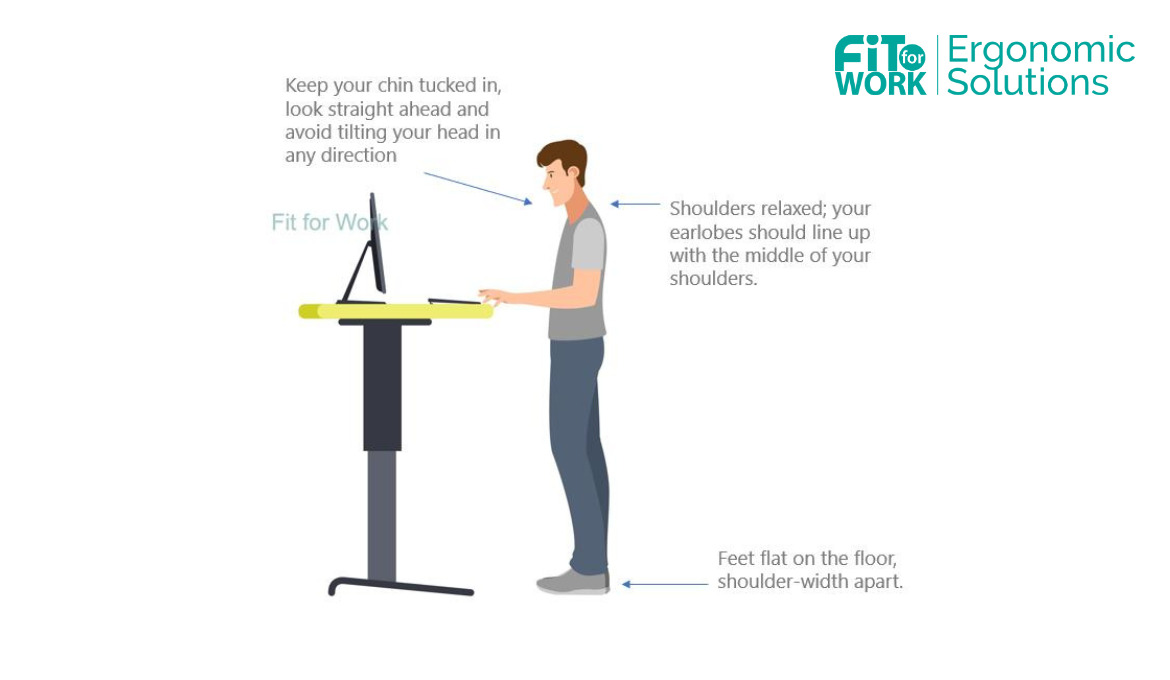Table of contents:
3.3 Rounded shoulders and kyphosis
4. Postural variations in different people
4.1 Factors influencing posture
4.2 Potential posture-related challenges
5. Postural exercises your employees can do at work
6. Key elements of correct standing posture
7. Key elements of correct sitting posture
8. How ergonomics support correct posture
8.2 Placement of computer equipment and accessories
8.3 Correct sitting, standing, and walking posture
10. Why good posture is important
11. Mastering posture with ergonomics: a path to successful business
“Your posture is the key to your personal and professional foundation.”
— Cindy Ann Peterson, Author of My Style, My Way: Top Experts Reveal How to Create Yours Today
As an employer who supports employee wellness, it is essential to recognise the profound significance of Cindy Ann Peterson’s quote. Your employees should observe good posture for invaluable reasons.
Correct posture conveys professionalism, confidence, and attentiveness, which can positively impact interactions with colleagues, clients, and superiors, ultimately leading to improved productivity, enhanced professional image, and overall career success.
Practising good posture allows for the correction of posture problems, such as rounded shoulders or forward head posture, which can alleviate discomfort and prevent long-term complications.
By integrating ergonomic principles into the workplace, you can further reinforce the benefits of practising good stance and create an environment that actively promotes employees’ physical well-being and postural correction.
Ergonomics and the posture of the human body share a close connection as they both focus on optimising physical well-being. Ergonomics is vital in promoting correct posture by providing ergonomic furniture, equipment, and workstations that support proper alignment and reduce strain on the body.As you read on, you will learn about the types of posture, how to fix bad ones, how ergonomics support it, and more. This blog will share insights on how the correct posture of your employees can help your business succeed.
What is posture?
You may have a sufficient understanding of good posture, but first, let’s define it.
Posture means the position and alignment of the body while sitting, standing, or moving. It encompasses how muscles and bones work together to support the body’s weight and maintain balance.
Now, let’s define the correct posture.
Correct posture involves maintaining the body in a position that minimises strain on the muscles, ligaments, and joints. It entails proper alignment of the spine, balanced distribution of body weight, and engagement of core muscles for stability.
Improving posture at work is a vital endeavour that can significantly impact employee well-being and productivity. With the increasing prevalence of sedentary jobs, it has become crucial for employers to prioritise strategies and initiatives that promote good posture among their workforce.
Studies conducted among office workers have found that approximately 34% experience lower back pain (LBP) every year. There may be a lot of factors, but bad posture is a leading contributor to LBP.
Types of postures
It is important for you to know how to fix posture because it directly impacts the well-being and productivity of your employees. Of course, it’s not the same level as how professionals (i.e., orthopedists) can fix it. But knowing the different types can help identify potential causes of discomfort and pain in your workforce.
Here are the different types of postures:
Normal or ideal

This refers to the optimal alignment of the body where the spine is in a natural, balanced position. It involves properly aligning the head, neck, shoulders, spine, and pelvis with evenly distributed body weight. Ideal posture promotes efficient movement, minimises strain on joints and muscles, and reduces musculoskeletal issues.
Forward head
This type is characterised by the head protruding forward from the neutral position, extending the neck and the shoulders rounded. Forward head is often caused by prolonged periods of sitting, looking down at electronic devices, or poor ergonomic positioning. It can cause neck pain, muscle imbalances, and strain on the cervical spine.
You can read our blog about tech neck, which gives tips on how to improve posture, especially the forward head posture.
Rounded shoulders and kyphosis
Rounded shoulders, also known as kyphosis, involve a forward rounding of the shoulders, causing the upper back to curve excessively. This is commonly associated with slouching and a hunched appearance and is one of the most common posture problems. Rounded shoulders can lead to muscle imbalances, decreased range of motion, and upper back and shoulder discomfort.
Swayback
This type is characterised by an exaggerated lower back curvature, causing the pelvis to tilt forward, the hips to shift backwards, and the upper body to lean backwards. This posture often results in an excessive arch in the lower back and a protruding abdomen, leading to lower back pain, tight hip flexors, and weak abdominal muscles.
Flat back
Flat back posture is characterised by a decreased natural curve in the lower back, resulting in a flatter appearance. This type often involves the pelvis tilting backwards, causing the spine to straighten or flatten. It can lead to muscle imbalances, limited mobility in the spine, and increased stress on the lower back.
Maintaining correct back posture is crucial for your employees to promote a healthy, pain-free spine. The discussed bad postures may be difficult to correct if they have had them for a long time, but with the help of professional ergonomic intervention, they can still be improved.
Request a demo of our ErgoEval Tool to correct their postures following an ergonomic self-assessment.
Postural variations in different people

Posture at work plays a crucial role in influencing the postural variations observed in employees. Here are the following details they should be aware of.
Factors influencing posture
- Muscle mass: Greater muscle mass can lead to increased tension and strain on the muscles, potentially impacting the stance if not properly managed.
- Body structure: Differences in skeletal structure, such as broader shoulders and narrower hips, can influence posture. These structural variations may require specific attention to ensure proper alignment and balance.
- Anatomical differences: Some individuals generally have wider hips and a lower centre of gravity than others. These structural variances can impact the alignment and balance of the spine, influencing posture.
- Hormonal Factors: Hormonal changes throughout a woman’s life, such as during pregnancy or menopause, can affect the ligaments and joints, potentially leading to postural changes. Hormonal fluctuations may also impact muscle tone and flexibility.
Potential posture-related challenges
- Sedentary lifestyle: Prolonged periods of sitting, whether due to desk jobs or leisure activities, can contribute to poor posture habits. Your employees should always observe the best posture for working at a desk.
- Heavy lifting and physical labour: Examples are lifting heavy objects or engaging in manual labour. These activities can place additional stress on the body and lead to postural imbalances or injuries if not performed with proper technique and posture.
- Lack of postural awareness: Some people may overlook or downplay the importance of posture. This lack of awareness can result in a poor one and a higher likelihood of experiencing posture-related challenges.

- High-heeled shoes: Wearing high-heeled shoes can alter the alignment of the feet, ankles, knees, and spine, putting additional stress on specific muscles and contributing to postural imbalances.
- Breast size: Larger breasts can shift the centre of gravity forward, potentially causing rounding of the shoulders and increased curvature of the upper back.
- Pregnancy: During pregnancy, the body experiences significant changes, including weight gain and hormonal shifts. These changes can impact the alignment and stability of the spine, leading to postural adjustments and potential challenges.
- Menopause: The decline in oestrogen levels during menopause can affect bone density and muscle strength, potentially influencing posture and increasing the risk of postural issues.
Postural exercises your employees can do at work
Maintaining good posture is crucial for overall employee well-being, especially in the workplace where extended periods of sitting and repetitive tasks can take a toll on their bodies.
Fortunately, there are effective exercises that can help counteract the adverse effects of sedentary work environments. One of the best ways to correct posture is by incorporating specific exercises targeting the muscles responsible for proper alignment.
By dedicating just a few minutes each day to these posture-enhancing exercises, your employees can significantly improve their posture, alleviate discomfort, and enhance their overall health and productivity.
Here are some simple step-by-step exercises that your employees can do at work to improve their posture:
Exercise 1: Shoulder Rolls
Step 1: Sit straight in your chair with your feet flat on the floor.
Step 2: Roll your shoulders backwards in a circular motion, starting from the front and moving towards the back.
Step 3: Repeat this motion several times, allowing your shoulders to move freely.
Step 4: Take deep breaths while performing the rolls to relax your upper body further. This helps in sitting with good posture.
Exercise 2: Desk Stretches

Step 1: Stand up from your chair and place your hands on your lower back.
Step 2: Gently lean back, arching your spine and opening your chest.
Step 3: Hold this stretch for 10-15 seconds, feeling the stretch in your chest and upper back.
Step 4: Repeat the stretch 2-3 times to release tension.
Exercise 3: Chin Tucks
Step 1: Sit or stand up straight with your shoulders relaxed.
Step 2: Slowly and gently retract your chin, pulling it towards your neck.
Step 3: Hold this position for 5-10 seconds, feeling a gentle stretch in the back of your neck.
Step 4: Release the tuck and repeat the movement 5-10 times to help properly align your head and neck.
Exercise 4: Core Engagement
Step 1: Sit up straight with your feet flat on the floor.
Step 2: As you take a deep breath, release the air while gently drawing your navel towards your spine, activating and involving your core muscles.
Step 3: Hold this engagement for 10-15 seconds while maintaining normal breathing.
Step 4: Release and repeat the engagement 2-3 times to strengthen your core.
By integrating these simple exercises into their daily routine at work, your employees can make significant strides in improving their posture and overall well-being. Encourage them to take regular daily breaks to perform these exercises and remind them of the importance of maintaining good posture for their long-term health and comfort.
Your employees also need to know about key elements of sitting and standing posture because these habits directly impact their musculoskeletal health and overall well-being.
Understanding the proper alignment of the spine, the positioning of the head and neck, and the engagement of core muscles while sitting or standing will help them have a good posture.
Key elements of correct standing posture

- Alignment of the spine and body: Maintaining a straight and upright posture from head to toe.
- Balanced weight distribution: Distributing body weight evenly between both feet.
- Engagement of core muscles: Activating the abdominal and back muscles to provide stability and support.
- Relaxed shoulders and arms: Keeping the shoulders down and relaxed, allowing the arms to hang naturally by the sides.
- Proper footwear for support: Wearing appropriate footwear that provides adequate arch support and cushioning for the feet.
Key elements of correct sitting posture

- Alignment of the spine and pelvis: Maintaining a straight and neutral position of the spine and pelvis while seated.
- Support for the lower back and lumbar curve: Using appropriate lumbar support to maintain the natural curve.
- Positioning of the head, neck, and shoulders: Keeping the head aligned with the spine, neck relaxed, and shoulders squared.
- Placement and positioning of arms and wrists: Ensuring that arms are relaxed, elbows bent at a comfortable angle, and wrists in a neutral position.
- Proper positioning of feet and legs: Keeping feet flat on the floor or using a footrest, with knees bent at 90 degrees, and thighs parallel to the ground.
How ergonomics support correct posture
Ergonomics can also teach you and your employees how to keep good posture. But what is it?
Ergonomics is the scientific study of designing and arranging work environments, products, and systems to optimise human well-being and performance. It aims to create an efficient and comfortable interaction between individuals and their work environment. To discover in-depth information about it, check out our blog about ergonomics.
When it comes to posture, ergonomics plays a crucial role by focusing on the design of furniture, equipment, and workstations to promote proper posture and reduce the risk of musculoskeletal disorders. Thus, implementing ergonomics in your employees’ workplace is a great posture help.
The following are the ergonomic principles for workstations, which your employees should observe. It helps improve posture for sitting.
Proper desk and chair
- Ensure that the chair height allows your feet to rest flat on the floor, with knees bent at a 90-degree angle. The thighs should be parallel to the ground.
- Adjust the seat depth so that there is a small gap (around 2-3 fingers) between the edge of the seat and the back of your knees.
- Utilise a chair with proper lumbar support or use a lumbar pillow to maintain the natural curve of your lower back.
- Set the desk height to allow your forearms to rest parallel to the floor while maintaining a relaxed posture.
- Position the computer monitor at eye level and approximately an arm’s length away to avoid straining your neck and eyes.
Placement of computer equipment and accessories
- Place the keyboard directly in front of you, allowing your elbows to stay relaxed and close to your sides. Maintain a slight downward slope of the keyboard to keep your wrists neutral.
- Position the mouse within easy reach, at the same height as the keyboard, to avoid unnecessary reaching or straining.
- When referencing documents, use a document holder positioned at the same height and distance as the monitor to reduce neck and eye strain.
- Keep cables organised and out of the way to prevent tripping hazards and maintain a clutter-free workspace. It prevents the need to reach or stretch, promoting better posture.
The best posture for working at a computer is achieved with the ergonomically correct workstation. Check out the essential tips we shared.
Correct sitting, standing, and walking posture
- Sitting: Maintain proper alignment of the spine and pelvis, support the lower back with lumbar support, and keep feet flat on the floor or a footrest. Observe the ergonomic principles.
- Standing: Stand tall with shoulders back, engage core muscles, distribute weight evenly on both feet, and avoid locking knees.
- Walking: Walk with a straight spine, relaxed shoulders, and head held high. Take smooth and natural strides, and ensure that shoes provide adequate support and cushioning.
To know more about the essential considerations in achieving an ergonomic workstation at the office, check out our blog that shares a basic checklist for an ergonomic office.
You must also ensure you allow professional ergonomist intervention as you assess your ergonomic workplace. Our Individual Virtual Ergonomic Assessment can help you out, whether in person or through video conferencing.
Common posture mistakes

- Slouching or rounded back: Hunching the back and shoulders forward, causing an unnatural curve in the spine.
- Forward head posture: Jutting the head forward, straining the neck and upper back muscles.
- Crossed legs and uneven weight distribution: Sitting with crossed legs or placing more weight on one leg, leading to imbalances and strain on the hips and spine.
- Incorrect arm and wrist positioning: Holding the arms too high or too low, and bending the wrists excessively, which can lead to discomfort and strain in the arms and shoulders.
- Lack of lower back support: Failing to provide proper lumbar support, resulting in a flattening of the lower back curve and an increased risk of lower back pain and discomfort.
Still, consulting a health professional is the right way to know if you have a good posture.
Advise your employees that even if their postures look and feel fine, it is crucial to have their postures professionally checked. Correct posture of standing, for instance, doesn’t just mean standing straight.
Why good posture is important
Good posture holds immense importance for you and your employees, providing benefits that contribute to the business’s success and the workforce’s well-being.
- Reduction of musculoskeletal disorders: Maintaining good posture significantly reduces the risk of musculoskeletal disorders, such as back pain, neck strain, and repetitive strain injuries. This leads to a healthier workforce with fewer work-related health issues, reducing healthcare costs for employers.
- Prevention of chronic pain and injuries: Good posture helps prevent chronic pain and injuries resulting from poor alignment and strain on muscles and joints. By promoting proper posture, employers can minimise employee absences due to pain-related issues, leading to lower absenteeism rates and improved productivity.
- Enhancement of productivity and focus: Good posture improves blood circulation and oxygen flow, which enhances alertness, concentration, and cognitive function. Employees with proper posture are more likely to stay focused, complete tasks efficiently, and maintain higher productivity throughout the workday.

- Improvement in overall well-being: Maintaining good posture contributes to overall well-being, both physically and mentally. It reduces stress on the body, improves energy levels, and promotes better self-confidence and a positive mindset among employees. This, in turn, fosters a healthier and more harmonious work environment.
Emphasising the importance of good posture not only benefits the employees’ health and well-being but also yields positive outcomes for the employers.
Companies prioritising and promoting good posture practices can experience a higher return on investment (ROI) through reduced healthcare costs, improved productivity, lower absenteeism rates, and a more engaged and satisfied workforce.
By following our tips to better posture and creating a culture that values and encourages good posture habits, employers can create a win-win situation for their business and employees.
Mastering posture with ergonomics: a path to successful business

In summary, maintaining good posture is essential for your employees. By prioritising proper posture, individuals can reduce the risk of musculoskeletal disorders, prevent chronic pain and injuries, enhance productivity and focus, and improve overall well-being.
Share the tips here on how to work on good posture with your employees, like the proper posture for standing, sitting, and walking.
You benefit from a healthier workforce with lower healthcare costs, reduced absenteeism rates, and increased productivity. Emphasising good posture promotes physical health and fosters a positive work environment, leading to higher employee engagement and satisfaction.
Remember, keeping correct posture is not just knowing how to sit up straight. It entails a lot of factors and needs ergonomic support.
Consider undergoing Ergonomic Trainings with us. We offer formal and interactive talks within a meeting space or through video conferencing. It’s about time you and your employees benefit from the gift ergonomics. Book your training session today!



